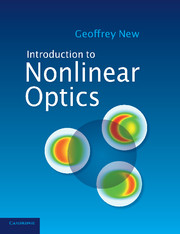Book contents
- Frontmatter
- Contents
- Preface
- Acknowledgements
- 1 Introduction
- 2 Frequency mixing
- 3 Crystal optics
- 4 Nonlinear optics in crystals
- 5 Third-order nonlinear processes
- 6 Dispersion and optical pulses
- 7 Nonlinear optics with pulses
- 8 Some quantum mechanics
- 9 Resonant effects
- 10 High harmonic generation
- Appendix A Conventions and units
- Appendix B Linear and nonlinear susceptibilities in the time and frequency domains
- Appendix C Definition of the nonlinear coefficients
- Appendix D Non-zero d elements in non-centrosymmetric crystals
- Appendix E Real fields, complex fields, and the analytic signal
- Appendix F Geometry of the grating pair
- Appendix G The paraxial wave equation
- Appendix H Useful formulae for numerical simulations
- Appendix I Useful constants
- Answers to problems
- Further Reading
- References
- Index
5 - Third-order nonlinear processes
Published online by Cambridge University Press: 05 June 2012
- Frontmatter
- Contents
- Preface
- Acknowledgements
- 1 Introduction
- 2 Frequency mixing
- 3 Crystal optics
- 4 Nonlinear optics in crystals
- 5 Third-order nonlinear processes
- 6 Dispersion and optical pulses
- 7 Nonlinear optics with pulses
- 8 Some quantum mechanics
- 9 Resonant effects
- 10 High harmonic generation
- Appendix A Conventions and units
- Appendix B Linear and nonlinear susceptibilities in the time and frequency domains
- Appendix C Definition of the nonlinear coefficients
- Appendix D Non-zero d elements in non-centrosymmetric crystals
- Appendix E Real fields, complex fields, and the analytic signal
- Appendix F Geometry of the grating pair
- Appendix G The paraxial wave equation
- Appendix H Useful formulae for numerical simulations
- Appendix I Useful constants
- Answers to problems
- Further Reading
- References
- Index
Summary
Introduction
Third-order nonlinear processes are based on the term ε0χ(3)E in the polarisation expansion of Eq. (1.24). Just as the second-order processes of the previous chapter coupled three waves together, so third-order processes couple four waves together, and hence are sometimes called four-wave processes.
Third-order processes are in some ways simpler and in other ways more complicated than their second-order counterparts. Perhaps the most important difference is that third-order interactions can occur in centrosymmetric media. This means that, while crystals can be used if desired, one is often dealing with optically isotropic materials in which the complexity of crystal optics is absent. However, the tensor nature of the third-order coefficients is still not entirely straightforward, even in isotropic media.
A second issue is that phase matching is automatic for many third-order processes and, even when it is not, the existence of four waves, potentially travelling in four different directions, makes phase matching easier to achieve. Of course, phase matching was also automatic at second order for the Pockels effect and optical rectification, but those were somewhat special cases involving DC fields.
At first sight, automatic phase matching sounds like a good thing, but the benefit (if it is such) comes at a serious price. When phase matching was critical, and one had to work to achieve it for a particular combination of frequencies, it did at least provide a way of promoting one particular nonlinear process, while discriminating against all the others.
- Type
- Chapter
- Information
- Introduction to Nonlinear Optics , pp. 76 - 115Publisher: Cambridge University PressPrint publication year: 2011



